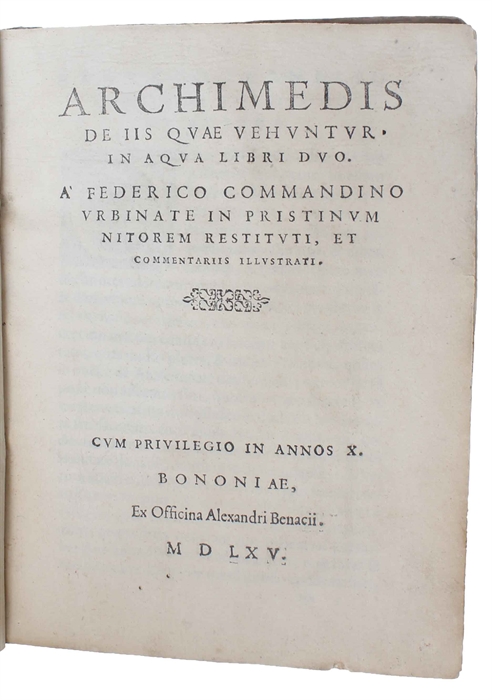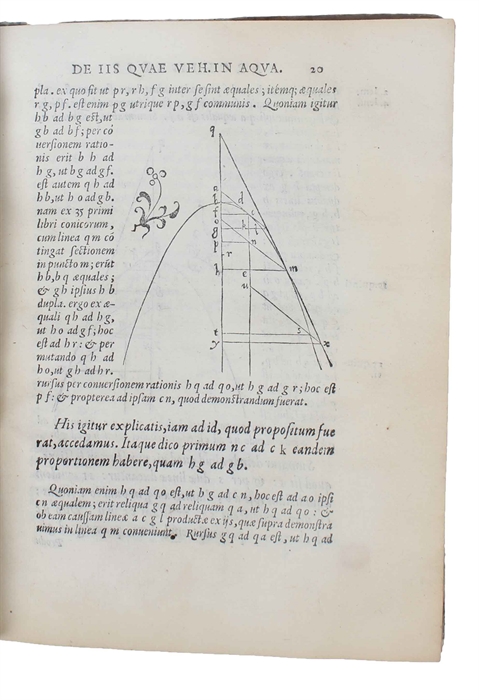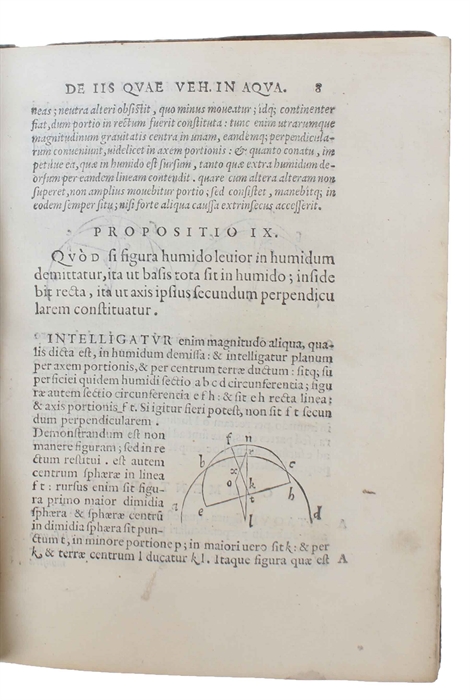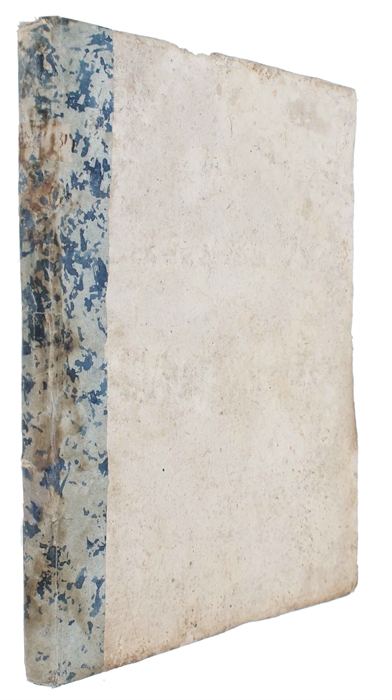THE FOUNDING WORK ON HYDROSTATICS
ARCHIMEDES.
De iis quae vehuntur in Aqua Libri Duo. A’ Federico Commandino Urbinate in pristinum nitorem restituti, et commentariis illustrati.
Bologna, Alessandreo Benacci, 1565. 4to. In contemporary blank cardboards with marbled paper back-strip. Ff 8-12 with small brown dot to lower outer margin, not affecting text. A fine copy. [4], 43 ff. + 1 blank. (Erroneously paginated f. 33 as 25 and f. 44 as 43).
First edition of Commandino's translation, and accompanying mathematical additions, of Archimedes' work on floating bodies, being the foundational work of hydrostatics. Commandino's own mathematical additions include the very first attempt to fill the gap in the incomplete proof of propositions 2 in book II of the Latin translation made by the Flemish Willem Moerbeke in 1269. "This edition of Commandino remained the reference until the early twentieth century and the work of Heiberg after the discovery of the Archimedes palimpsest". (D.B.I).
"In hydrostatics [Archimedes] described the equilibrium of floating bodies and stated the famous proposition - known by his name - that, if a solid floats in a fluid, the weight of the solid is equal to that of the fluid displaced and, if a solid heavier than a fluid is weighed in it, it will be lighter than its true weight by the weight of the fluid displaced. We owe to Archimedes the full exposition of the doctrine of levers and pulleys." (PMM, p. 44)
The work consists of two parts: The first is to the effect that the pressure excerted by any part of a fluid on the fluid is downward. The second postulate states that the pressure of the fluid on a body placed in it is exerted upward along the perpendicular through the center of the body.
However, Book II contained many sophisticated ideas and complex geometric constructions and did not have the appeal of Book I. Only after Greek geometry was combined with algebra, trigonometry, and analytical geometry, the present work being one of the earliest attempts to do this, and the field of mechanics reached the maturity to handle the concepts of equilibrium and stability that Archimedes introduced was Book II seriously studied. It then became the standard starting point for scientists and naval architects examining the stability of ships and other floating bodies.
"Archimedes left to posterity his famous treatise "On Floating Bodies", which establishes the physical foundations for the floatability and stability of ships and other maritime objects. Yet since this treatise was long lost and also simply ignored by practitioners, it took many centuries before Archimedes' brilliant insights were actually applied in ship design and ship safety assessment." (Nowacki, The Heritage of Archimedes in Ship Hydrostatics: 2000 Years from Theories to Applications).
A Greek manuscript dating from about the ninth century and containing both books of On Floating Bodies was translated into Latin by the Flemish Dominican William of Moerbeke in 1269, along with other works of Archimedes from other manuscripts. The tracks of the Greek manuscript were lost in the fourteenth century, but Moerbeke's holograph remains intact in the Vatican library (Codex Ottobonianus Latinus 1850) [5, 8]. Moerbeke's Latin translation was the source of all versions of On Floating Bodies from his time until the twentieth century.
"In 1543 Tartaglia [...] the Moerbeke translations of On the Equilibrium of Planes and Book I of On Floating Bodies (leaving the erroneous impression that he had made these translations from a Greek manuscript, which he had not since he merely repeated the texts of the Madrid manuscript with virtually all their errors). Incidentally, Curtius Trioianus published from the legacy of Tartaglia both books of On Floating Bodies in Moerbeke's translation (Venice, 1565). The key event, however, in the further spread of Archimedes was the aforementioned editio princeps of the Greek text with the accompanying Latin translation of James of Cremona at Basel in 1544. Since the Greek text rested ultimately on manuscript A,On Floating Bodies was not included. A further Latin translation of the Archimedean texts was published by the perceptive mathematician Federigo Commandino [...], which the translator supplemented with a skillful mathematical emendation of Moerbeke's translation of On Floating Bodies (Bologna,1565) but without any knowledge of the long lost Greek text." (DSB)
Adams, 1533
Riccardi, I, 42- 5
Honeyman 131;
Macclesfield 183
D.B.I., XXVII, p. 604.
Bibliotheca Mechanica 78
Graesse I, 180.
BM 000105842
Order-nr.: 52966




